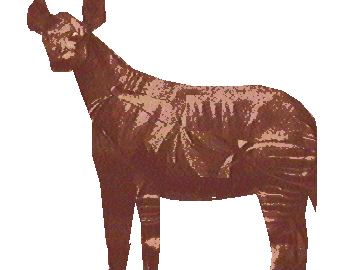pop up description layer
HOME
Cryptozoology UFO Mysteries Aviation Space & Time Dinosaurs Geology Archaeology Exploration 7 Wonders Surprising Science Troubled History Library Laboratory Attic Theater Store Index/Site Map Cyclorama
Search the Site: |
|
A Gallery of Cryptozoological AlumniAll the following creatures have been discovered in the past 100 years:
Megamouth Shark - This species of shark was completely unknown till 1976 when one, caught in a U.S. Navy trawler's parachute anchor, was hauled up from the depths near Hawaii. As dangerous as the name sounds, and as nasty as the creature looks, this extremely rare shark is harmless to humans. Its huge mouth is full of tiny teeth which are used to filter the water as the animal sucks in the tiny shrimp and plankton that make up it's diet. Two other members of the shark family, the basking shark and whale shark, use the same feeding technique. The largest Megamouth ever found was about 14 feet in length. For years, only male Megamouths had been found, but then in 1994 a female, the seventh specimen ever seen, was washed ashore in Japan.
Panda - Stories of the Giant Panda's existence, and even hides, had come back to the west starting at the end of the 19th century. It took 50 years, though, till a living Panda was brought to the west. The Giant Panda lives in the cool, damp bamboo forests of central China, near Tibet. Living at altitudes of 5,000 to 13,000 feet, the Giant Panda feeds on the bamboo using its sharp claws to strip open the plant. Full grown Pandas are bear-like, have black and white coats, weight up to 330 pounds and grow 5 feet in length. Hunters and zoo keepers diligently sought the Panda until Mrs. William Harkness, who husband had died on a Panda expedition, found a baby asleep in a tree in Northern China and, in 1937, sent it to the Chicago Zoo.
The Okapi was first sent to zoos in 1920 and has adapted quite well. They can now be found in captivity around the world, though they are rare in the wild. Scientists believe they are the closest living relative of the giraffe. If nothing else the lesson from the Okapi is it is important for naturalists to take serious the stories of native peoples.
The Mountain Gorilla - This animal, the largest primate alive, was unknown till 1902 when a German, Captain von Beringe, observed some tall "man-like" apes near one of the volcanoes of the Virunga region of what now is Rwanda. He shot a specimen and brought the animal back to Europe. The sub-speices is named after him: Gorilla Gorilla Beringe. The first expedition to study the Mountain Gorilla in its natural habitat didn't arrive in Africa until the 1960's. Late in that decade Dr. Dian Fossey founded the Karisoke Research Centre in Rwanda and started its long running gorilla study. Unfortunately poaching and encroaching human activity is threatening the Mountain Gorilla and as few as 320 individuals may still survive.
The King Cheetah - Paul and Lena Bottriell, two cryptozoogists, pursued this animal diligently until, 1975, they were able to see and photograph it. The animal they observed was larger than a regular cheetah and had a remarkably different pattern of spots and stripes on its coat. The big cat seemed incredibly elusive. When a specimen was finally examined it became obvious why. The King Cheetah wasn't a new species, but a variation on the standard cheetah. A King Cheetah is the result of a "recessive" or hidden gene. When a cheetah inherits this gene from both his parents he will be a King Cheetah. If he inherits only from one side he will be a standard cheetah, but will still carry the gene. This means that King Cheetahs can disappear completely from a population of cheetahs for a length of time, then reappear when two standard cheetahs with the right recessive genes mate. This made "finding" the King Cheetah extremely difficult.
Copyright Lee Krystek 1996. All Rights Reserved. |
|
Related Links |
|
|



 The
Okapi - For years Europeans brushed aside stories from
native pygmies of the Congo about a creature that looked like
a cross between a zebra and a giraffe. It wasn't until 1900
that the explorer, Sir Harry Johnson, was able to send
to Europe a complete skin and two skulls of the creature proving
its existence.
The
Okapi - For years Europeans brushed aside stories from
native pygmies of the Congo about a creature that looked like
a cross between a zebra and a giraffe. It wasn't until 1900
that the explorer, Sir Harry Johnson, was able to send
to Europe a complete skin and two skulls of the creature proving
its existence.
